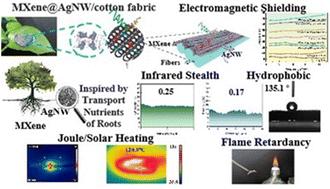Flexible multifunctional MXene@Ag nanowires/cotton fabric inspired by transport of nutrients by roots for electromagnetic shielding, infrared stealth, Joule/solar heating and flame retardancy
IF 10.7
2区 材料科学
Q1 CHEMISTRY, PHYSICAL
引用次数: 0
Abstract
With the rapid development of 5G communication technology and intelligent detection technology, electromagnetic shielding/infrared stealth fabrics with Joule/solar heating performance can meet the needs of wearable electronic devices for multi-application scenarios. Two-dimensional (2D) transition metal carbides and nitrides (MXenes) are ideal candidates for constructing efficient conductive networks in EMI SE fabrics due to their layered structure and high conductivity. However, it is difficult for MXene nanosheets to assemble into excellent interconnected conductive networks due to the irregular size and stacking of MXene sheets after MXene etching. Inspired by transport of nutrients by roots, a three-dimensional (3D) efficient conductive network was constructed by bridging one-dimensional (1D) Ag nanowires (AgNWs) into the highly conductive 2D MXenes, and a series of flexible multifunctional MXene@AgNW/cotton fabrics with excellent EMI SE performance was obtained. The average EMI SE value of MXene@AgNW/cotton fabrics can reach 70.6 dB in the X band. The oxidation resistance of the fabric is enhanced after spraying perfluorooctyltriethoxysilane (PFOTES) on the surface, and the surface water contact angle reaches 135.1°, providing excellent self-cleaning performance. MXene@AgNW/cotton fabric exhibits an average infrared emissivity of 0.25 (3–5 μm) and 0.17 (8–14 μm), showing excellent camouflage capability for infrared thermal signals under an infrared camera, generating a temperature difference of about 132.2 °C with a hot stage at 200 °C. MXene@AgNW/cotton fabric shows good electrical heating performance under low voltage loading (temperature reaches 150 °C at 3.5 V) and it also exhibits photothermal properties, showing a temperature of 120 °C under light density irradiation of 1900 W m−2 within 180 s, which can realize the functions of hot compress therapy and cold preservation. The limiting oxygen index (LOI) value of MXene@AgNW/cotton fabric is 27.5%, which proves that MXene@AgNW/cotton fabric exhibits fire safety in practical applications. This work provides a paradigm for the construction of flexible multifunctional EMI SE fabrics.

灵活的多功能 MXene@Ag 纳米线/棉织物,灵感来自根部营养物质的运输,可用于电磁屏蔽、红外线隐身、焦耳/太阳能加热和阻燃
随着 5G 通信技术和智能检测技术的快速发展,具有焦耳/太阳能加热性能的电磁屏蔽/红外隐身织物可满足可穿戴电子设备的多应用场景需求。二维(2D)过渡金属碳化物和氮化物(MXenes)具有层状结构和高导电性,是在 EMI SE 织物中构建高效导电网络的理想候选材料。然而,由于 MXene 蚀刻后 MXene 片的尺寸和堆叠不规则,MXene 纳米片很难组装成出色的互连导电网络。受根部养分运输的启发,通过将一维(1D)银纳米线(AgNW)桥接到高导电性二维 MXene 中,构建了三维(3D)高效导电网络,并获得了一系列具有优异 EMI SE 性能的柔性多功能 MXene@AgNW/ 棉织物。MXene@AgNW/cotton 织物在 X 波段的平均 EMI SE 值高达 70.6 dB。在织物表面喷涂全氟辛基三乙氧基硅烷(PFOTES)后,织物的抗氧化性增强,表面水接触角达到 135.1°,具有优异的自清洁性能。MXene@AgNW/cotton 织物的平均红外发射率分别为 0.25(3-5 μm)和 0.17(8-14 μm),在红外摄像机下对红外热信号具有极佳的伪装能力,在 200 ℃ 的高温阶段可产生约 132.2 ℃ 的温差。MXene@AgNW/cotton 织物在低电压负载下具有良好的电加热性能(3.5 V 时温度达到 150 ℃),同时还具有光热特性,在光密度为 1900 W m-2 的照射下,180 秒内温度达到 120 ℃,可实现热敷治疗和冷藏保鲜功能。MXene@AgNW/cotton 织物的极限氧指数(LOI)值为 27.5%,证明了 MXene@AgNW/cotton 织物在实际应用中的防火安全性。这项工作为构建柔性多功能 EMI SE 织物提供了范例。
本文章由计算机程序翻译,如有差异,请以英文原文为准。
求助全文
约1分钟内获得全文
求助全文
来源期刊

Journal of Materials Chemistry A
CHEMISTRY, PHYSICAL-ENERGY & FUELS
CiteScore
19.50
自引率
5.00%
发文量
1892
审稿时长
1.5 months
期刊介绍:
The Journal of Materials Chemistry A, B & C covers a wide range of high-quality studies in the field of materials chemistry, with each section focusing on specific applications of the materials studied. Journal of Materials Chemistry A emphasizes applications in energy and sustainability, including topics such as artificial photosynthesis, batteries, and fuel cells. Journal of Materials Chemistry B focuses on applications in biology and medicine, while Journal of Materials Chemistry C covers applications in optical, magnetic, and electronic devices. Example topic areas within the scope of Journal of Materials Chemistry A include catalysis, green/sustainable materials, sensors, and water treatment, among others.
 求助内容:
求助内容: 应助结果提醒方式:
应助结果提醒方式:


